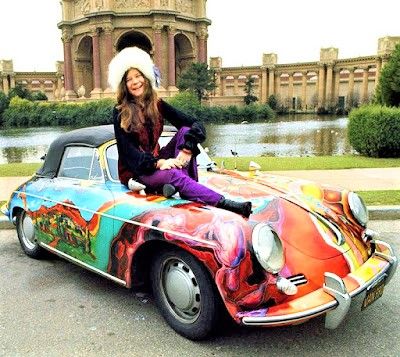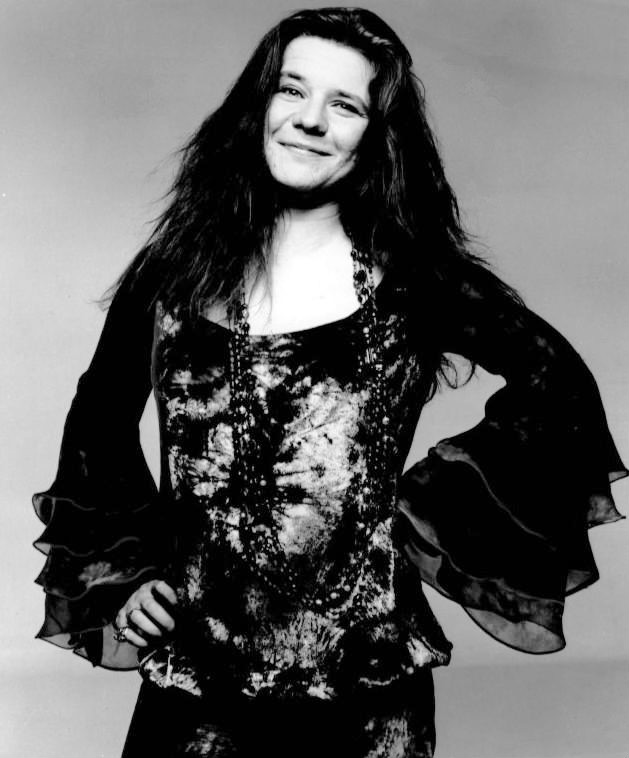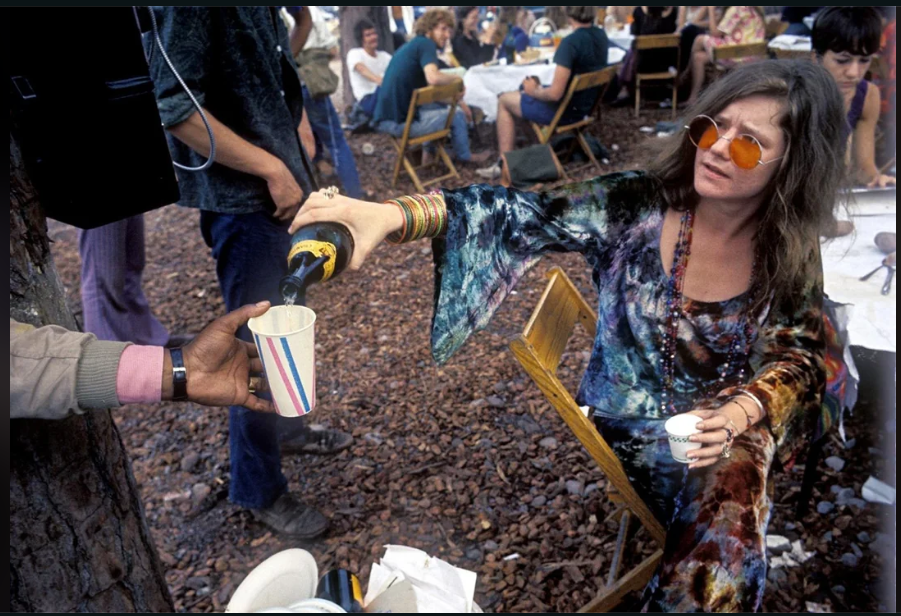
Janis Joplin was a trailblazing American rock singer and cultural icon of the 1960s, whose powerful, emotive vocals and fearless individuality left an indelible mark on the music world, paving the way for future generations of female rock artists.
She became a leading figure in the psychedelic rock scene of the 1960s, which was closely associated with the hippie movement.
Singer like no other.
Her career was brief, yet her music remains powerful and moving. The singer from Port Arthur, Texas, had incomparable vocals that were unfettered, raw, and straight from the heart.
She was inspired by blues icons like Lead Belly and Bessie Smith, and she stood in stark contrast to other women singing at the time with a softer, folkier touch.
Her energy was fueled by a relentless various hard drugs addiction and heavy drinking.
Behind her bawdy, brassy image was a sensitive, scarred, and shy woman who loved to read.
Joplin died of an accidental drug overdose at a tragically young age of 27. But she packed a lot of living—and music—into those too-few years.
Childhood and young age :
Janis Lyn Joplin was born on Jan. 19, 1943 in the Gulf Coast oil town of Port Arthur, Texas. Her father worked for Texaco, and her mother was a college registrar.
When she was young, Joplin was a good student and sang in a church choir, but she was a misfit and a rebel in high school. She and friends traveled to bars in nearby Louisiana, and she began listening to blues and jazz artists like Lead Belly, Bessie Smith, and Ma Rainey, as well as the folk singer Odetta.
After high school, Joplin studied at Lamar State College of Technology in nearby Beaumont, Texas, and at Port Arthur College, she took secretarial courses. She worked in a local library one summer and also waitressed before moving to Los Angeles in 1961.
First gigs
By 1962, Joplin was back in Texas, studying art at the University of Texas at Austin. She played gigs at informal venues on campus and at the well-known Threadgill’s, a bar set in a former gas station.
Joplin left school and headed for San Francisco in 1963 in hopes of getting her musical career off the ground. She performed on a side stage at the 1963 Monterey Folk Festival.
Living in the Bay Area in 1963, Joplin began performing the bluesy songs of Bessie Smith. Her drug use increased as did her drinking. Her trademark liquor was Southern Comfort.
Joining Big Brother
In 1966, Joplin auditioned and joined a new rock band in San Francisco, Big Brother and the Holding Company. The band grew popular in the Bay Area, and their big break came with their performance at the Monterey Pop Festival in 1967. Their on-stage hit was “Ball and Chain,” a song originally sung by the legendary Big Mama Thornton, that showcased Joplin’s now legendary vocals.
In the wake of the Monterey performance, Big Brother signed with Columbia Records, and Albert Grossman, who managed the Band, Bob Dylan, and Peter, Paul and Mary, became their manager. Their first album for Columbia, “Cheap Thrills,” in 1968 went gold, with hits like Piece of My Heart” and “Summertime.” But the attention paid to Joplin’s talents caused tension among band members.
The design of the “Cheap Thrills” 1968. cover was created by underground cartoonist R. Crumb. Crumb would become famous for such comic creations as “Fritz the Cat” and “Mr. Natural.”

Janis Joplin in 1969.
Kozmic Blues Band and solo
Joplin played her last gig with Big Brother in December 1968 before going solo, and she released her album “I Got Dem Ol’ Kozmic Blues Again Mama!” in September 1969 with Kozmic Blues Band. Cuts included “Try (Just a Little Bit Harder)” and a cover version of the Bee Gees song “To Love Somebody.”
In May 1969, Joplin appeared on the cover of Newsweek magazine next to the headline “Rebirth of the Blues.” She had been slated to grace the cover a month earlier but was bumped off by the death of former President Dwight Eisenhower.
Joplin appeared with singer Tom Jones to sing “Raise Your Hands” on his television show “This Is Tom Jones” in 1969. He recalled later that she told him that she didn’t do variety shows, but she admired his voice and made an exception for him.
August 16th 1969. Janis performed at Woodstock festival .
Touring in November 1969, Joplin was arrested for the use of “vulgar and indecent language” in a performance in Tampa, Florida. Unlike the Doors’ Jim Morrison, who was arrested onstage during a Florida performance earlier that year, Joplin was allowed to finish the show and was handcuffed backstage. She was released on a bond and eventually was fined .
During a 1969 appearance on television, Joplin admitted that she was a major fan of singer Tina Turner. In November of that year, Joplin made an guest appearance with Turner during a show at Madison Square Garden, and the two sang a duet. Turner was opening for the Rolling Stones.
Janis waiting for performance at Woodstock festival 16th august 1969.
Addiction
Joplin grew addicted to heroin. She tried to kick the habit several times, including during a trip in early 1970 to Brazil. But she relapsed later that year while recording her second album “Pearl” in Los Angeles. with the Full Tilt Boogie Band in 1970.
She wrote the album’s cut “Move Over” and co-wrote the a cappella ditty “Mercedes Benz” with a beat poet named Michael McClure.
In same period learning that her idol Bessie Smith had been laid to rest in an unmarked grave in Pennsylvania after her death in a 1937 car accident, Joplin and Juanita Green, the daughter of one of Smith’s employees, paid for a tombstone for the singer. The epitaph reads: “The Greatest Blues Singer in the World Will Never Stop Singing.”
The singer, then 27 years old, accidentally overdosed on Oct. 4, 1970, in a room at Hollywood’s Landmark Hotel.
The song “Buried Alive In The Blues” was cut as an instrumental because Joplin died before she could record the vocals.
After she was cremated, her ashes were scattered in the Pacific Ocean and along Stinson Beach in Northern California.
Three days before she died, Joplin recorded a birthday greeting for her friend, former Beatle John Lennon. He later said that the tape arrived at his home in New York following her death.
In her will, Joplin left $2,500 for friends to throw a party in case she died. The party was held on Oct. 26 at The Lion’s Share club in San Anselmo, California.
The invitations read: “Drinks are on Pearl,” and the Grateful Dead played.
Released in 1971, “Pearl” album quickly rose to the top of the charts.
The hit single “Me and Bobby McGee” was written by Kris Kristofferson, who was a former lover.
Other lovers included musicians “Pigpen” McKernan of the Grateful Dead, Country Joe McDonald, Leonard Cohen, and football star Joe Namath.

Janis Joplin at Woodstock festival 1969.
Counter-Cultural Icon:
Joplin embodied the spirit of rebellion and non-conformity that characterized the hippie movement.
Her bohemian fashion sense, which included colorful clothing, beads, and feathers, became a symbol of the counterculture’s rejection of mainstream societal norms.
Joplin’s lyrics often explored themes of personal freedom, self-expression, and individuality, which resonated deeply with the values of the hippie movement.
Songs like “Piece of My Heart” and “Me and Bobby McGee” conveyed a sense of longing for personal liberation, mirroring the ideals of the era.
Joplin’s prominence and success in the music industry during a time of social upheaval made her a cultural catalyst.
Her rise to fame and her interactions with other influential musicians of the era, like Jimi Hendrix and The Grateful Dead, helped to bridge the worlds of music and counterculture, further solidifying her role as an icon of the hippie movement.
Joplin’s role as a female rock artist in a predominantly male-dominated industry was significant.
She broke gender norms and stereotypes, serving as an inspiration to women who sought to defy societal expectations,
Her legacy continues to influence and inspire generations of artists and free spirits who embrace the spirit of the 1960s counterculture.
1979: ‘The Rose’ reflects Joplin’s life: The movie “The Rose” was based loosely upon Joplin’s life. Lead actress Bette Midler was nominated for an Academy Award for her performance.
1992: Laura Joplin tells her story – The singer’s sister Laura Joplin published a book “Love, Janis,” that also was adapted into a play.
It portrayed the musician as smart, shy, and sensitive. On tour, she would carry bags filled with books to read, and she had a dog named Thurber after the humor writer James Thurber.
Twenty-five years after her death, Joplin was inducted into the Rock and Roll Hall of Fame in 1995.
Ten years later, she was given a Recording Academy Lifetime Achievement Award at the Grammys.
Joplin was given a star on the Hollywood Walk of Fame. On hand for the ceremony were Kris Kristofferson, producer Clive Davis, and the star’s brother and sister Michael and Laura Joplin.
Janis Joplin Signature
Discography
list of Janis Joplin’s studio albums, their release years, and some notable singles from each album:
“Big Brother and the Holding Company” (1967)
Notable Singles: “Down on Me,” “Coo Coo,” “Blindman,” “Bye, Bye Baby,” “Call on Me”
“Cheap Thrills” (1968)
Notable Singles: “Piece of My Heart,” “Summertime,” “Ball and Chain,” “Combination of the Two”
“I Got Dem Ol’ Kozmic Blues Again Mama!” (1969)
Notable Singles: “Try (Just a Little Bit Harder),” “Kozmic Blues,” “To Love Somebody”
“Pearl” (1971, released posthumously)
Notable Singles: “Me and Bobby McGee,” “Mercedes Benz,” “Cry Baby,” “Get It While You Can”
“Farewell Song” (1982, posthumous compilation)
Notable Singles: This album is a compilation of previously unreleased tracks.
Discover more from Multipolar World
Subscribe to get the latest posts to your email.

